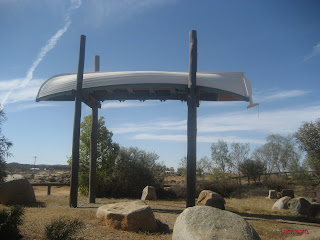A road trip seemed like an appropriate way to celebrate Australian Day. Especially since the road we had chosen to travel would take us near some of the most significant landmarks in Australia's history. Though when we shared our destination, Tibooburra, with our friends we received several blank looks. Perhaps we had an incorrect pronunciation. However, when we described where we were going we got "why would you want to go there?" For most, the idea of visiting the remote Outback town of New South Wales was unimaginable unless you were to pass through on your way to somewhere else. For us it was the desire to better understand the vast open spaces of Australia's interior and the people that called those spaces home.
We became interested in this isolated town after reading Julietta Jameson's book "Tibooburra and the Legend of the Tree of Knowledge." The book left us with a clearer vision of what life--in what is called the hottest spot in NSW--was like, but we felt a visit would bring a better understanding of the people who live there.
We knew that our choice to visit the the Corner County (so named because of the joining of three states: New South Wales, South Australia, and Queensland) was a bit risky during the summer months, but it was in the intense heat that we wanted to see the area. We figure you can't really understand one of the harshest climates in the world unless you see it in it's extreme.
Our several thousand kilometer journey--many of those on dirt tracks--took us: to empty State Parks; past dozen of emus, kangaroos, and feral goats; near a handful of homesteads; and through two Outback Cities. Each passing kilometer brought us closer to understanding boundless space, unbridled wildness, unpredictable wilderness, and the invincibility of the elements. We were captivated by the unfolding landscape and enthralled by the overwhelming sense of freedom that surround us.
We didn't actually arrive in Tibooburra until our third day on the road. As we pulled into town, we were surprised by the setting. We had imagined a small settlement sitting in the desert, but found a town nestled among boulders and granite outcrops. When we climbed out of the car we were greeted with the suffocating heat, as the mercury climbed towards 105 degrees fahrenheit. The streets were vacant as expected in such heat, but it didn't stop us from taking a quick look around. The landmarks we had read about in the book suddenly came to life. It was easy to imagine Liz, Peter, Jungle, Joanne, Skyo, and Debbie sitting on the verandah of the Family Hotel, once the sun dropped below the horizon. Telling yarns till late at night. We chuckled as we looked at the Post Office Box with it's stickers announcing mail collection on Tuesday and Thursday at 1:45. No next day service in this part of the world. We tried to call in at the National Park Office, but it was temporarily closed. I wondered if it was a seasonal closure, or if the locals had chased the latest NSP employee away. At the end of town we found the replica of the boat explorer Charles Sturt carried all the way from Adelaide in 1884 to sail the inland sea he never found. As we stood under the upside down boat that is perched on 2 poles, I couldn't help but wonder how the men of this expedition were able to maintain their belief of an inland sea. How were they able to carry on day after day for several years through such an intense environment? Then I remembered my earlier sense of freedom, and realized that it is that sense of sovereignty that is the heartbeat of the Australian Outback .
sunday song – carol of the bells
2 days ago









It's all about space and the human desire to fill it, isn't it? The imperial gaze--that is the eye of those who are piveleged to travel the world, always see empty space and feel that they are ordained to fill it with their presence. Your post made me think of the Spanish explorers who ventured into the Americas, particularly the northern deserts of Mexico and the U.S. Southwest. They saw nothing but empty space and the anticipated fruits of colonization. In they process they overlooked the glory and bounty of nature AND the presence of those who came before them. Love that upside down vessel. gonzalee
ReplyDeleteGonzalee--Good food for thought. When I read about it I thought the vessel would be bigger, but still I wouldn't want to be carrying it across the desert.
ReplyDelete